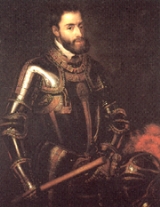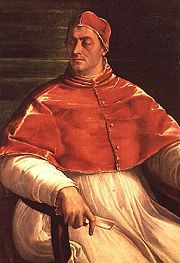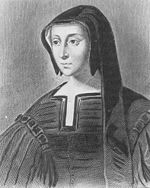
War of the League of Cognac
Encyclopedia
The War of the League of Cognac (1526–30) was fought between the Habsburg
dominions of Charles V
—primarily Spain
and the Holy Roman Empire
—and the League of Cognac, an alliance including France
, Pope Clement VII
, the Republic of Venice
, England
, the Duchy of Milan
and Republic of Florence
.
, Clement, together with the Republic of Venice, began to organize an alliance to drive Charles V from Italy. Francis, having signed the Treaty of Madrid, was released and returned to France, where he quickly announced his intention to assist Clement. Thus, in 1526, the League of Cognac was signed by Francis, Clement, Venice, Florence, and the Sforza of Milan
, who desired to throw off the Imperial hegemony over them. Henry VIII of England
, thwarted in his desire to have the treaty signed in England, refused to join.
s under Georg Frundsberg and a Spanish army under Charles of Bourbon; the two forces combined at Piacenza
and advanced on Rome. Francesco Guicciardini
, now in command of the Papal armies, proved unable to resist them; and when the Duke of Bourbon was killed, his underpaid army sacked
the city, forcing the Pope to flee.
through Genoa
—where Andrea Doria
had quickly joined the French and seized much of the Genoese fleet—to Naples
, where it proceeded to dig itself in for an extended siege.
), together with the decisive defeat of a French relief force under Francis de Bourbon, Comte de St. Pol
at the Battle of Landriano
, ended Francis's hopes of regaining his hold on Italy.

 Following the defeat of his armies, Francis sought peace with Charles. The negotiations began in July 1529 in the border city of Cambrai
Following the defeat of his armies, Francis sought peace with Charles. The negotiations began in July 1529 in the border city of Cambrai
; they were conducted primarily between Francis's mother Louise of Savoy
for the French and her sister-in-law, Margaret of Austria for her nephew the Emperor (leading to its being known as the Paix des Dames), Charles himself having sailed from Barcelona
to Italy shortly before. The final tems largely mirrored those of the Treaty of Madrid three years earlier; Francis surrendered his rights to Artois
, Flanders
, and Tournai
, and was obliged to pay a ransom of two million golden écu
s before his sons were to be released. Removed, however, were both the humiliating surrender of Burgundy
itself and the various points dealing with Charles de Bourbon, who, having been killed two years prior, was no longer a candidate for leading an independent Kingdom of Provence. The final treaty, signed on 5 August, removed France from the war, leaving Venice, Florence, and the Pope alone against Charles.
Charles, having arrived in Genoa, proceeded to Bologna
to meet with the Pope. Clement absolved the participants of the sack of Rome and promised to crown Charles. In return, he received Ravenna
and Cervia
; cities which the Republic of Venice was forced to surrender—along with her remaining possessions in Apulia
—to Charles in exchange for being permitted to retain the holdings she had won at Marignano
. Finally, Francesco was permitted to return to Milan—Charles having abandoned his earlier plan to place Alessandro de' Medici on the throne, in part due to Venetian objections—for the sum of 900,000 scudi.
 The Republic of Florence
The Republic of Florence
alone continued to resist the Imperial forces, which were led by the Prince of Orange
. A Florentine army under Francesco Ferruccio
engaged the armies of the Emperor at the Battle of Gavinana
in 1530, and, although the Prince of Orange himself was killed, the Imperial army won a decisive victory and the Republic of Florence
surrendered ten days later. Alessandro de' Medici was then installed as Duke of Florence.
Habsburg
The House of Habsburg , also found as Hapsburg, and also known as House of Austria is one of the most important royal houses of Europe and is best known for being an origin of all of the formally elected Holy Roman Emperors between 1438 and 1740, as well as rulers of the Austrian Empire and...
dominions of Charles V
Charles V, Holy Roman Emperor
Charles V was ruler of the Holy Roman Empire from 1519 and, as Charles I, of the Spanish Empire from 1516 until his voluntary retirement and abdication in favor of his younger brother Ferdinand I and his son Philip II in 1556.As...
—primarily Spain
Habsburg Spain
Habsburg Spain refers to the history of Spain over the 16th and 17th centuries , when Spain was ruled by the major branch of the Habsburg dynasty...
and the Holy Roman Empire
Holy Roman Empire
The Holy Roman Empire was a realm that existed from 962 to 1806 in Central Europe.It was ruled by the Holy Roman Emperor. Its character changed during the Middle Ages and the Early Modern period, when the power of the emperor gradually weakened in favour of the princes...
—and the League of Cognac, an alliance including France
France
The French Republic , The French Republic , The French Republic , (commonly known as France , is a unitary semi-presidential republic in Western Europe with several overseas territories and islands located on other continents and in the Indian, Pacific, and Atlantic oceans. Metropolitan France...
, Pope Clement VII
Pope Clement VII
Clement VII , born Giulio di Giuliano de' Medici, was a cardinal from 1513 to 1523 and was Pope from 1523 to 1534.-Early life:...
, the Republic of Venice
Republic of Venice
The Republic of Venice or Venetian Republic was a state originating from the city of Venice in Northeastern Italy. It existed for over a millennium, from the late 7th century until 1797. It was formally known as the Most Serene Republic of Venice and is often referred to as La Serenissima, in...
, England
Kingdom of England
The Kingdom of England was, from 927 to 1707, a sovereign state to the northwest of continental Europe. At its height, the Kingdom of England spanned the southern two-thirds of the island of Great Britain and several smaller outlying islands; what today comprises the legal jurisdiction of England...
, the Duchy of Milan
Duchy of Milan
The Duchy of Milan , was created on the 1st of may 1395, when Gian Galeazzo Visconti, Lord of Milan, purchased a diploma for 100,000 Florins from King Wenceslaus. It was this diploma that installed, Gian Galeazzo as Duke of Milan and Count of Pavia...
and Republic of Florence
Republic of Florence
The Republic of Florence , or the Florentine Republic, was a city-state that was centered on the city of Florence, located in modern Tuscany, Italy. The republic was founded in 1115, when the Florentine people rebelled against the Margraviate of Tuscany upon Margravine Matilda's death. The...
.
Prelude
Shocked by the defeat of the French in the Italian War of 1521Italian War of 1521
The Italian War of 1521–26, sometimes known as the Four Years' War, was a part of the Italian Wars. The war pitted Francis I of France and the Republic of Venice against the Holy Roman Emperor Charles V, Henry VIII of England, and the Papal States...
, Clement, together with the Republic of Venice, began to organize an alliance to drive Charles V from Italy. Francis, having signed the Treaty of Madrid, was released and returned to France, where he quickly announced his intention to assist Clement. Thus, in 1526, the League of Cognac was signed by Francis, Clement, Venice, Florence, and the Sforza of Milan
Milan
Milan is the second-largest city in Italy and the capital city of the region of Lombardy and of the province of Milan. The city proper has a population of about 1.3 million, while its urban area, roughly coinciding with its administrative province and the bordering Province of Monza and Brianza ,...
, who desired to throw off the Imperial hegemony over them. Henry VIII of England
Henry VIII of England
Henry VIII was King of England from 21 April 1509 until his death. He was Lord, and later King, of Ireland, as well as continuing the nominal claim by the English monarchs to the Kingdom of France...
, thwarted in his desire to have the treaty signed in England, refused to join.
Initial moves
The League quickly seized Lodi, but Imperial troops marched into Lombardy and soon forced Sforza to abandon Milan. The Colonna, meanwhile, organized an attack on Rome, defeating the Papal forces and briefly seizing control of the city; they were soon paid off and departed, however.Rome
Charles V now gathered a force of landsknechtLandsknecht
Landsknechte were European, predominantly German mercenary pikemen and supporting foot soldiers from the late 15th to the late 16th century, and achieved the reputation for being the universal mercenary of Early modern Europe.-Etymology:The term is from German, Land "land, country" + Knecht...
s under Georg Frundsberg and a Spanish army under Charles of Bourbon; the two forces combined at Piacenza
Piacenza
Piacenza is a city and comune in the Emilia-Romagna region of northern Italy. It is the capital of the province of Piacenza...
and advanced on Rome. Francesco Guicciardini
Francesco Guicciardini
Francesco Guicciardini was an Italian historian and statesman. A friend and critic of Niccolò Machiavelli, he is considered one of the major political writers of the Italian Renaissance...
, now in command of the Papal armies, proved unable to resist them; and when the Duke of Bourbon was killed, his underpaid army sacked
Sack of Rome (1527)
The Sack of Rome on 6 May 1527 was a military event carried out by the mutinous troops of Charles V, Holy Roman Emperor in Rome, then part of the Papal States...
the city, forcing the Pope to flee.
Naples
The destruction of Rome, and the consequent removal of Clement from any real role in the war, prompted frantic action on the part of the French. On 30 April 1527, Henry VIII and Francis signed the Treaty of Westminster, pledging to combine their forces against Charles. Francis, having finally drawn Henry VIII into the League, sent an army under Odet de Foix and Pedro Navarro, Count of OlivetoPedro Navarro, Count of Oliveto
Don Pedro Navarro, Count of Oliveto was a Spanish military engineer and general who participated in the War of the League of Cambrai. At the Battle of Ravenna in 1512 he commanded the Spanish and Papal infantry, but was captured by the French...
through Genoa
Genoa
Genoa |Ligurian]] Zena ; Latin and, archaically, English Genua) is a city and an important seaport in northern Italy, the capital of the Province of Genoa and of the region of Liguria....
—where Andrea Doria
Andrea Doria
Andrea Doria was an Italian condottiere and admiral from Genoa.-Early life:Doria was born at Oneglia from the ancient Genoese family, the Doria di Oneglia branch of the old Doria, de Oria or de Auria family. His parents were related: Ceva Doria, co-lord of Oneglia, and Caracosa Doria, of the...
had quickly joined the French and seized much of the Genoese fleet—to Naples
Naples
Naples is a city in Southern Italy, situated on the country's west coast by the Gulf of Naples. Lying between two notable volcanic regions, Mount Vesuvius and the Phlegraean Fields, it is the capital of the region of Campania and of the province of Naples...
, where it proceeded to dig itself in for an extended siege.
Genoa
Doria, however, soon deserted the French for Charles. The siege collapsed as plague broke out in the French camp, killing most of the army along with Foix and Navarro. Andrea Doria's offensive in Genoa (where he soon broke the blockade of the city and forced the surrender of the French at SavonaSavona
Savona is a seaport and comune in the northern Italian region of Liguria, capital of the Province of Savona, in the Riviera di Ponente on the Mediterranean Sea....
), together with the decisive defeat of a French relief force under Francis de Bourbon, Comte de St. Pol
Francis de Bourbon, Count of St. Pol
Francis I de Bourbon-Saint-Pol, Count of St. Pol and of Chaumont , was a French nobleman, Count of Saint-Pol, Duke of Estouteville and important military commander during the Italian Wars.Francis was the second son of Francis, Count of Vendôme and Marie of Luxembourg, Countess of Vendôme.He was...
at the Battle of Landriano
Battle of Landriano
The Battle of Landriano took place on 21 June 1529, between the French army under Francis de Bourbon, Comte de St. Pol and the Spanish army commanded by Don Antonio de Leyva, Duke of Terranova in the context of the War of the League of Cognac...
, ended Francis's hopes of regaining his hold on Italy.
Barcelona, Cambrai, and Bologna


Cambrai
Cambrai is a commune in the Nord department in northern France. It is a sub-prefecture of the department.Cambrai is the seat of an archdiocese whose jurisdiction was immense during the Middle Ages. The territory of the Bishopric of Cambrai, roughly coinciding with the shire of Brabant, included...
; they were conducted primarily between Francis's mother Louise of Savoy
Louise of Savoy
Louise of Savoy was a French noble, Duchess regnant of Auvergne and Bourbon, Duchess of Nemours, the mother of King Francis I of France...
for the French and her sister-in-law, Margaret of Austria for her nephew the Emperor (leading to its being known as the Paix des Dames), Charles himself having sailed from Barcelona
Barcelona
Barcelona is the second largest city in Spain after Madrid, and the capital of Catalonia, with a population of 1,621,537 within its administrative limits on a land area of...
to Italy shortly before. The final tems largely mirrored those of the Treaty of Madrid three years earlier; Francis surrendered his rights to Artois
Artois
Artois is a former province of northern France. Its territory has an area of around 4000 km² and a population of about one million. Its principal cities are Arras , Saint-Omer, Lens and Béthune.-Location:...
, Flanders
Flanders
Flanders is the community of the Flemings but also one of the institutions in Belgium, and a geographical region located in parts of present-day Belgium, France and the Netherlands. "Flanders" can also refer to the northern part of Belgium that contains Brussels, Bruges, Ghent and Antwerp...
, and Tournai
Tournai
Tournai is a Walloon city and municipality of Belgium located 85 kilometres southwest of Brussels, on the river Scheldt, in the province of Hainaut....
, and was obliged to pay a ransom of two million golden écu
ECU
ECU may refer to:Automotive terms* Electronic control unit, a generic term for any embedded system that controls one or more of the electrical systems or subsystems in a motor vehicle...
s before his sons were to be released. Removed, however, were both the humiliating surrender of Burgundy
Duchy of Burgundy
The Duchy of Burgundy , was heir to an ancient and prestigious reputation and a large division of the lands of the Second Kingdom of Burgundy and in its own right was one of the geographically larger ducal territories in the emergence of Early Modern Europe from Medieval Europe.Even in that...
itself and the various points dealing with Charles de Bourbon, who, having been killed two years prior, was no longer a candidate for leading an independent Kingdom of Provence. The final treaty, signed on 5 August, removed France from the war, leaving Venice, Florence, and the Pope alone against Charles.
Charles, having arrived in Genoa, proceeded to Bologna
Bologna
Bologna is the capital city of Emilia-Romagna, in the Po Valley of Northern Italy. The city lies between the Po River and the Apennine Mountains, more specifically, between the Reno River and the Savena River. Bologna is a lively and cosmopolitan Italian college city, with spectacular history,...
to meet with the Pope. Clement absolved the participants of the sack of Rome and promised to crown Charles. In return, he received Ravenna
Ravenna
Ravenna is the capital city of the Province of Ravenna in the Emilia-Romagna region of Italy and the second largest comune in Italy by land area, although, at , it is little more than half the size of the largest comune, Rome...
and Cervia
Cervia
Cervia is a town and comune in the province of Ravenna , central Italy.-History:Originally called Ficocle, it was probably of Greek origin and was located midway from current Cervia and Ravenna...
; cities which the Republic of Venice was forced to surrender—along with her remaining possessions in Apulia
Apulia
Apulia is a region in Southern Italy bordering the Adriatic Sea in the east, the Ionian Sea to the southeast, and the Strait of Òtranto and Gulf of Taranto in the south. Its most southern portion, known as Salento peninsula, forms a high heel on the "boot" of Italy. The region comprises , and...
—to Charles in exchange for being permitted to retain the holdings she had won at Marignano
Battle of Marignano
The Battle of Marignano was fought during the phase of the Italian Wars called the War of the League of Cambrai, between France and the Old Swiss Confederacy. It took place on September 13 and 15, 1515, near the town today called Melegnano, 16 km southeast of Milan...
. Finally, Francesco was permitted to return to Milan—Charles having abandoned his earlier plan to place Alessandro de' Medici on the throne, in part due to Venetian objections—for the sum of 900,000 scudi.
Florence

Republic of Florence
The Republic of Florence , or the Florentine Republic, was a city-state that was centered on the city of Florence, located in modern Tuscany, Italy. The republic was founded in 1115, when the Florentine people rebelled against the Margraviate of Tuscany upon Margravine Matilda's death. The...
alone continued to resist the Imperial forces, which were led by the Prince of Orange
Philibert of Châlon
Philibert de Châlon was the last prince of Orange from the house of Châlon.Born at Nozeroy to John IV of Chalon-Arlay, Philibert served Emperor Charles V as commander in Italy, fighting in the War of the League of Cognac. He took part in the Sack of Rome and was killed during the final stages of...
. A Florentine army under Francesco Ferruccio
Francesco Ferruccio
Francesco Ferruccio was an Italian captain from Florence who fought in the Italian Wars.-Biography:...
engaged the armies of the Emperor at the Battle of Gavinana
Battle of Gavinana
The Battle of Gavinana was a battle in the War of the League of Cognac. It was fought on 3 August 1530 between the city of Florence and the Imperial army of the Holy Roman Empire....
in 1530, and, although the Prince of Orange himself was killed, the Imperial army won a decisive victory and the Republic of Florence
Republic of Florence
The Republic of Florence , or the Florentine Republic, was a city-state that was centered on the city of Florence, located in modern Tuscany, Italy. The republic was founded in 1115, when the Florentine people rebelled against the Margraviate of Tuscany upon Margravine Matilda's death. The...
surrendered ten days later. Alessandro de' Medici was then installed as Duke of Florence.

